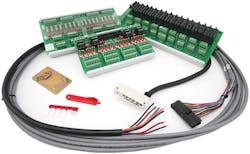Simplify Field Wiring
These mounting and wiring accessories include a variety of terminal extender cables, breakout boards, wiring harnesses, DIN-rail kits, jumper straps, rack adapters, and other components for mounting and wiring the vendor’s automation, control and I/O systems. SNAP TEX cables are six feet (1.8m) long jacketed, pre-wired cables that provide neat, bundled connections from analog and digital I/O modules to field devices, terminal strips and breakout boards. They snap neatly into the tops of I/O modules and terminate with color-coded flying leads, pre-stripped and tipped, ready for wiring. Breakout boards include the 32-channel SNAP-TEX-32 with straight-through connections; the SNAP-TEX-FB16-H and SNAP-TEX-FB16-L, offering 16-channel terminations with fuse-blown indicators for each channel, and 120-240V and 12-24V capability respectively; and the SNAP-TEX-MR10-16 and SNAP-TEX-MR10-4 breakout boards designed for high-current output switching of up to 10 amps per channel. Opto 22www.opto22.com800.321.6786

